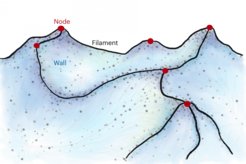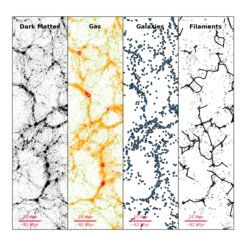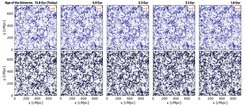Understanding the cosmic web: Unveiling the evolution of cosmic filaments with the MillenniumTNG simulation
A careful analysis of the filaments in the cosmic large-scale structure has revealed interesting new findings about the evolution and complexities of the cosmic web. While some filaments show a significant evolution – depending on their cosmic environment – global filament properties are preserved, which could be used in future cosmological studies. The MPA team also developed a new method to allow for rigorous calibration of the filament catalogues.
What are cosmic filaments?

In the 1980s, observations of galaxies in regions like the Perseus cluster, the Coma/A1367 supercluster, and the Center for Astrophysics galaxy survey unveiled a fascinating discovery: the universe is structured like a complex network, called the cosmic web. This structure is made of nodes, filaments, walls, and vast voids, intricately woven together. Dark matter and gas, influenced by gravity’s pull, sculpt this cosmic architecture, with galaxies serving as markers tracing its features. Since its discovery, the cosmic web has been meticulously mapped by numerous galaxy surveys, each providing unique insights into the structure of the cosmos.
While the dense clusters of galaxies, or nodes, have been thoroughly studied, the less dense and more intricate cosmic filaments remain less understood. Their faint signals make them difficult to observe, as research shows that dark matter density in these filaments is significantly lower than in clusters, complicating their detection in galaxy surveys.
Despite these challenges, cosmological simulations suggest that cosmic filaments contain over 50% of the universe’s matter. Understanding these structures is therefore essential for a comprehensive view of the universe, and to know how galaxies form and evolve within this large interconnected web.
New insights from the MillenniumTNG simulation

In this study, MPA researcher Daniela Galárraga-Espinosa, in collaboration with local and international colleagues, has utilized the new state-of-the-art numerical simulation, MillenniumTNG, to delve into the intricate structure of the cosmic web across different epochs of the universe. The hydro-dynamical runs at various redshifts (z = 0, 1, 2, 3, and 4) led to meticulously constructed catalogues of cosmic filaments. This backbone of the cosmic web could then be studied in terms of spatial evolution over cosmic time, as well as lengths, growth rates, and radial density profiles, providing unprecedented insights into the evolution and diversity of these cosmic structures:
1. Unveiling global properties of filament across time: Through careful analysis, the study showed that the filament lengths and density profiles across varying cosmic epochs are remarkably stable. The global population of cosmic filaments shows only minimal evolution over a span of approximately 12.25 billion years.
2. Tracking individual filaments: For the first time, the study has associated a large number of filaments across different redshifts, following the evolution of individual structures across time. While some filaments can significantly contract or elongate with time, the global filament properties are preserved. The team therefore plans to use fundamental filament properties for cosmological analyses in the next study.

3. Understanding cosmic filament diversity: The study also highlights the differences between filament populations at a specific time. At all redshifts, the longest filaments exceed 100 megaparsecs, two orders of magnitude longer than the shortest ones. In addition, these extreme-length filaments have very distinct density profiles. Complementing previous research, the study indicates that environmental factors could drive this diversity: filaments in high-density regions collapse and shorten over time, while those near cosmic voids expand as the cosmic web stretches.
4. Towards more robust filament catalogues: The team developed a method anchored in physical principles to allow for rigorous calibration and testing of the identified cosmic skeletons. This methodology will hopefully inspire future investigations to adopt similar robust approaches, fostering a more unified understanding of cosmic filament detection techniques within the scientific community.
These discoveries represent major advancements in our understanding of the Universe’s large-scale structure and open new avenues for exploring the complexities of the cosmic web.














